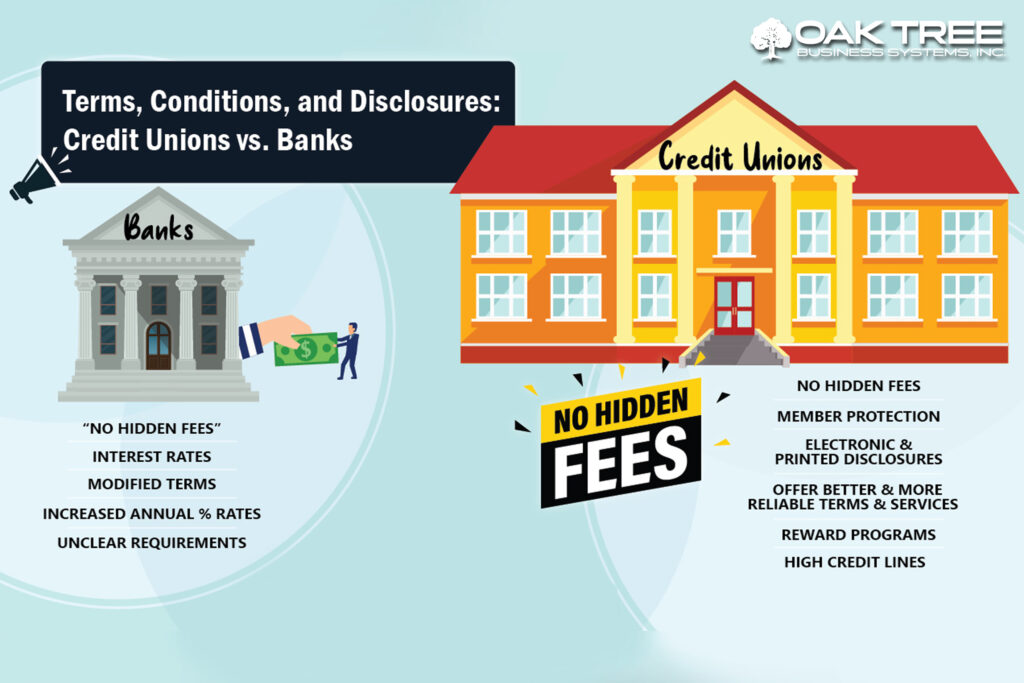
Terms, Conditions, and Disclosures
When it comes to the differences between Credit Unions vs. Banks Disclosures along with the terms and conditions there are some very important things to take into consideration.
- Regulations over the past decade have forced financial institutions to more clearly disclose their terms and conditions. For many, this has revealed bait-and-switch tactics and negatively impacted consumer bases.
- Disclosure statements today are offered both in physical print and electronic versions. Credit unions must evaluate their membership and prospective clients to determine which delivery method is preferred, as there isn’t a one-size-fits-all approach.
- Credit unions who are open and transparent with their terms and conditions are poised to seize on the next greatest opportunity – Millennials. Craving relationships with those they do business with, credit unions are positioned to capitalize on the largest generation.
Credit unions offering well-scripted terms, conditions, and disclosures will benefit both its members and the credit union itself. When companies, regardless of the industry, provide fair conditions and detailed disclosures, the level of consumer trust can be elevated, client satisfaction improved, the reputation of the company increased, and uncertainty is reduced.
Many credit unions are already providing transparent terms and conditions, helping members choose credit cards, banking accounts, and other services. Instead of hiding behind small print and lengthy copy, members appreciate the clarity. For credit unions, this is an opportunity that can be used to draw customers away from banks. What differences can we find between credit unions vs. banks’ disclosures?
The State of Banking Terms and Conditions
Many consumers prefer credit unions who offer transparent terms and detailed disclosures. In contrast, some banks have established ambiguous terms that affect a customer’s decisions. Buried within pages of terms are extra fees, complicated requirements, and unclear conditions.
While banks can have marketing powerhouses behind them promoting low or no fees, too often their advertising only tells a small part of the story. Credit unions offering better terms need to find and exploit where traditional banks are nickel-and-diming their customers. When consumers search for credit cards and other banking services, they look for financial institutions that can eliminate unnecessary fees, provide rewards, and offer high credit lines.
A History of Hidden Fees
Before 2010, many banks offered credit cards with high interest rates. The banks established introductory interest rates and attracted many new customers, and many still do. After six months, permanent interest rates tremendously increased the costs of some credit cards. Along with excessive penalties, modified terms, and increased annual percentage rates, banks had free reign to reel in and profit off of new customers
However, during the last 10 years, numerous financial institutions have significantly improved terms and conditions. The transition has mostly been driven by better-educated consumers and access to information online. New regulations have also begun requiring financial institutions to disclose important information. When consumers obtain a new credit card or open a new account, the financial institutions must describe their various policies, the impact of late payments, interest rates, and reward programs. With access to more information, consumers are more apt to find better terms for their banking needs.
Protecting Members and Credit Unions
When credit unions openly and clearly disclose terms and conditions, potential new members can easily compare terms against competing banks. Members will better understand how their decisions can impact fees, penalties, and interest rates without having the feeling that their financial institution is trying to play “gotcha” with their terms. In fact, this is where being a member versus being a customer has its benefits. Members are one with their financial institution, instead of just being “another number.”
Generally, transparent terms also benefit the credit union. Transparent disclosures reduce uncertainty. Once members understand the policies of each credit union, they can understand their financial obligations, the terms of each service, and any potential rewards. This understanding can significantly reduce aggravation by members and even thwart potential misrepresentation claims.
Various surveys indicate that transparent terms could considerably increase the percentage of members who refer to numerous friends. Additionally, the transparent guidelines may augment a company’s conversion rate of around 38 percent. When it comes to credit union vs. banks disclosures we see credit unions putting more concern on their members.
Electronic and Printed Disclosures
If a credit union offers an electronic disclosure, members can always access that disclosure while the credit union can easily provide additional copies. Electronic disclosures can also significantly increase trustworthiness, augment a company’s conversion rates, and improve transparency. The accessibility of electronic disclosures ultimately allows your members 24/7 access to any question they may have.
On the other hand, printed disclosures remain popular, especially with senior members. Many credit unions provide both electronic disclosures and printed disclosures. On-premise, printed disclosures allow members to easily review guidelines, policies of the credit union, terms, and various incentives.
As banking continually moves online, it is likely that printed disclosures will go the way of the rotary phone. Younger members may want their credit union to practice green banking and may gravitate to financial institutions committed to a paperless environment. Credit unions should take the opportunity and listen to their members’ preferences. Surveying your membership will improve the ability to service them in the way they most desire.
Emerging Trends in Credit Unions vs. Banks Disclosures
In the coming years, transparency will become ever more important in the consumer’s decision-making process. Financial institutions who are open about their terms and conditions will garner favor and trust much faster than those who continue to hide behind complicated disclosure statements. While bait-and-switch marketing tactics will continue to produce new members, it is the trust of a credit union’s membership that drives long-term profitability and growth. This will never be truer than with the millennial generation who craves a connection with those they do business with. And creating connections is where credit unions today have their greatest opportunity to grow. Finally, we are also seeing a lot of credit unions eliminating their fees. This is one thing with credit unions vs. banks disclosures, the credit unions are moving away from such fees.
When your credit union needs the best Membership Documents or Lending Documents they should look to Oak Tree. We know the difference between Credit Unions vs. Banks Disclosures because we are always monitoring the changes in the regulatory landscape and keeping our customers compliant in all of their forms.


